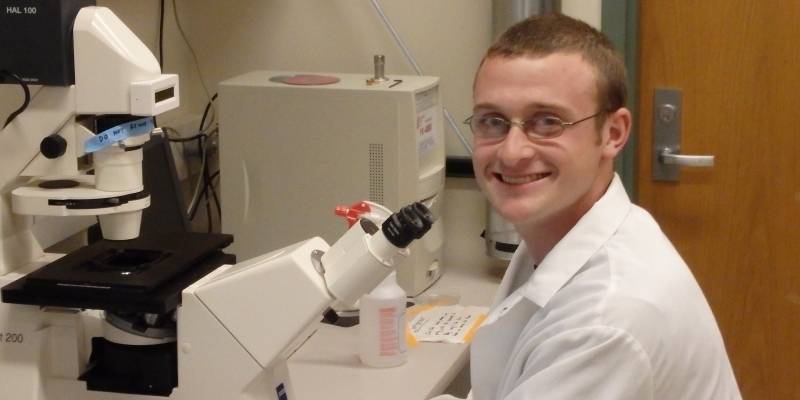On March 30th, Michael Munroe will be obtaining his Ph.D. I spoke to him about his science journey and uncovered not only the research he is pushing forward, but also who he is as a scientist. Munroe’s love of learning inspired him to pursue research. During his undergraduate years, he studied exercise science because of his background with athletics and interest in physiology. Through his education, he came to be fascinated by research since it was what provided the information behind the textbooks. The idea of creating knowledge intrigued him. Thus, he began learning more about the experimental techniques in exercise science. After meeting with researchers in both exercise physiology and molecular biology, a new world of knowledge opened up to him. Since then, he has been on the pursuit of furthering the barriers of science in the world of muscle physiology.
Munroe’s main research interest lies in investigating how alterations at the cellular level result in functional changes to skeletal muscle, specifically in the context of disease and aging. He focuses on the effect of both immobilization and remobilization on perivascular stem cell (i.e. pericyte) quantity and function in mice. Pericytes are cells that line small blood vessels throughout the body. For his dissertation research, he aims to understand and characterize pericyte quantity, localization, and gene expression changes after immobilization and remobilization.
Additionally, his work includes the development of therapeutic interventions aimed at reversing muscle atrophy post-disuse. Muscle atrophy is when muscles waste away, and this is a big problem with the aging population. With the lack of use of muscles, many older adults find that they lose muscle function and thus, their ability to do day-to-day activities. Munroe would like to focus on research that can prevent this muscle loss in older adults which will help increase their lifespan and improve their quality of life. More specifically, he wants his future work to include studying how pericyte transplantation might affect aged populations suffering from skeletal muscle disuse atrophy. From a biochemical standpoint, understanding how disuse atrophy alters neuromuscular junction functionality is interesting given that the partial restoration of muscle strength is independent of muscle mass recovery. This goes against the common belief that muscles absolutely need to get bigger to for one’s strength to increase. He believes that a better understanding of the relationship between how neural signals interact with muscle disuse and recovery will provide new insight into the development of possible therapeutic interventions.
As with any great passion, there is a downside to Munroes’s love for research as well. His biggest pet peeve is not knowing why previously successful experiments fail in subsequent attempts. There are many scientists out there who can relate to this, yet as Alexander Graham Bell said, “It is the perseverance in the pursuit of studies that is really wanted.” Munroe pursued, and now he is two months away from getting the big degree and teaching the world more about the “development of a stem cell-based therapy for the recovery of skeletal muscle mass and function following immobilization.”
Munroe’s favorite part about being a scientist is having a career where there is always something new to learn or do, and never getting stuck in a boring daily routine. When asked to describe a day he found something exciting, he told me about one of his earlier projects. He was looking at how the nutritional supplement HMB can affect cognition in aged mice. HMB is known to reduce muscle waste, especially during times at which muscle atrophy is accelerated. He observed that aged mice on a HMB diet were more successful at a particular behavioral task compared to mice who were not, suggesting that HMB might impact cognitive function as well; a really unexpected finding.
Munroe describes himself as knowledgeable, practical, and motivated. His favorite journals include Nature Protocols, Cell Press, Experimental Gerontology, and Stem Cell Reports. His considerable knowledge of science is accompanied by his humility and passion for helping others succeed. Whenever a colleague turns to him to assistance, he goes above and beyond in guiding them. His undergraduate mentee, Amber Lopez, says “Michael is a good mentor because after he teaches me a technique, he lets me execute it a couple of times so I get better at it. He also walks me through protocols so that I truly understand the experiment he is doing, and am not just doing things mindlessly. I also really enjoy that he sends me scientific articles so that I am not lost when we talk about different experiments and techniques that the lab uses.”
Let us all wish him luck and hope his plans work out in the final stretch of his graduate career! (puns intended)








